Innovative short food supply chains
AIMS OF CHAPTER/ABSTRACT
The present chapter introduces the short food supply chain through the best practices, and case studies to provide a better understanding of innovative short value chains which become available in all the European Union member states. It also aims to present the differences between traditional direct selling and new alternative food chains. Finally, it gives a practical guide for setting and boosting up a new group of farmers and describes the main steps of organizing farmers’ markets.
KEYWORDS
short food supply chain, alternative food system, direct sale, cooperation, innovative good practices, facilitator
LEARNING OBJECTIVES
The main objectives of this chapter are to understand the different definitions of short and alternative food supply chains and to identify different types of short chains. The chapter describes the main steps of setting up SFSC groups which will provide an easy-to-use guideline for facilitators. Some tips and practical advice help the better understand the process of market organisation and give a wider picture about the role of rural facilitators.
INTRODUCTION
The long food supply chains raise several issues such as sustainability of European small-scale farming, environmental damages due to long distribution channels, transparency, and loss of confidence in industrial food processing. That is why farmers, rural development experts, and in some cases consumers, local communities are looking for new, innovative ways to relocalize food chains. The development of short food supply chains and the involvement of small-scale farmers in alternative food systems may be an effective response to the above-mentioned challenges (Kneafsey et al. 2013, Ilbery et al., 2004, Benedek et al., 2018).
DEFINITIONS OF SHORT FOOD SUPPLY CHAINS AND THEIR MAIN TYPES
The globalization of retail, and thus of food retail, was a long and organically integrated process that began in developed Western countries as early as the 1960s. Due to globalization, the small-scale producers had to face challenges to be able to join the modern supply chains thus they lost a great part of their market. This process was reflected in Central European countries at the beginning of the 1990s. The small farmers in this region still suffer from the volatility of markets and the vulnerability of long supply chains. Nowadays these traditional channels are living their renaissance - more and more people get to know the benefits of that way of consumption - but it is complicated to be able to operate a short supply chain and the importance of facilitators is getting more recognized.
Reflecting on the actual situation, it should be also mentioned that the SARS-COV-2 global pandemic had a predestined influence on food chains and an emerging focus was given to local food systems. In 2020 we were witnessing the improvement of local community-based food supply thanks to the valorisation of local goods. As farmers must continue the production the role of facilitators is important to make available the local foods for consumers.
DEFINITION
Hereinafter we will discuss the most relevant definitions which are related to short food supply chains. These are the local food system, the alternative food chains, short food supply chains, and direct sales. In this subchapter, the most frequent categorizations of SFSCs will be presented to identify the differences between direct and independent sales and collaborative SFSCs.

Figure 1 Summary of relevant definitions related to short food supply chains. Source: Rastion (2015), Murdoch et al. (2000), and Kneafsay et al. (2015), own composition.
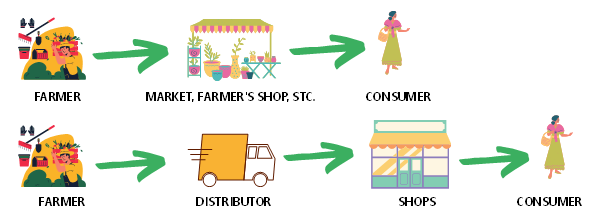
Figure 2 Definitions of direct sale and short food supply chains without (1) and with (2) one intermediate Understanding the different definitions. Source: own composition.
Figure 3 Systemic approach of the local food system. Source: own composition.
The definition of a short food supply chain (henceforward SFSC) explains the relation system between the farmers and consumers in a narrower sense, however, severe differences can be shown among the member states. To sum up the aim of short food chains:
- Decreasing the distance – both physically and personally – between the small-scale farmers and consumers
- Stabilizing the income of agricultural producers
- Supplying the consumer with healthy and locally made food
- Decreasing environmental pollution
- Creating a food supply policy based on real funds
- Fighting against the further decreasing of agricultural lands.
Besides, it can be an advantage for the local economy, that the number of jobs in the area can even increase due to the consumer demand of labour-intensive cultures.
It is hard to find the perfect definition but the main characteristics are the same from every perspective. The mainly highlighted issue is the proximity (economic, social, environmental, spatial) in most of the used terms in literacy.
According to the regulation on support for rural development by the European Agricultural Fund for Rural Development (Regulation (EU) No. 1305/2013 of the European Parliament and of the Council on support for rural development by the European Agricultural Fund for Rural (EAFRD) and repealing Council Regulation (EC) No 1698/2005), a ‘short supply chain’ means a supply chain involving a limited number of economic operators, committed to co-operation, local economic development, and close geographical and social relations between producers, processors, and consumers. It is important to note that this regulation recognizes the importance of social relationships between all people involved in the food chain and this point is also very important for understanding how collaborative SFSCs operate. A Commission delegated regulation stipulates that support for the establishment and development of short supply chains shall cover only supply chains involving no more than one intermediary between farmer and consumer (Article 11) (Kneafsay et al., 2015). This definition must have been implemented in every country in case of support of short food supply chains under the Rural Development Programme 2014-2020. Although it must be emphasised that more authorities use it as a generally accepted definition.
DIFFERENT WAYS TO SELL IN SHORT FOOD CHAINS
From farmers’ markets to box systems or community-supported agriculture, there is a wide variety of short food supply chains and local food systems. The typology can be as wide range as the definition itself. Two main categorizations are used in practice: the first sees the chains if there are 0 or one or a few intermediaries between producers and consumers, the second one observes the SFSCs from the point of view of sales categories.
A. Number of intermediaries
From this approach, we can distinguish direct sales and short chains when the consumer and the producer contact directly and the second type is when one (or as few as possible) intermediate actors are between them. From the aspect of this categorization, it is very important if the producer makes sales individually or in the group because the diverse activities need different competencies and factors, which influence investment and motivation (Table 1). In the case of the individual sale, we can still speak on short food supply chains if farmers work with other farmers or stakeholders to cooperate to produce, process, transport, or sell together. However, these definitions are not covered by regulatory frameworks. The principal is always the place where the added value is created and how farmers and consumers can be in a win-win situation.
|
Direct sale |
Methods of individual sale methods |
Sale at farms (farmer shop) Sale on the local market Roadside sale Mobil shop (van) Home delivery service Sale to a permanent group of regular customers Internet Pick your own Installed food machines |
|
Collective sale |
Shop (common) operated by cooperates or non-profit association Common association production, processing and/or marketing and /or common sale Consumer supported agriculture (CSA) Cooperatives’ shops |
|
|
Short-term sale methods |
Sale to retailers in the region |
Home delivery system via an intermediary Food retailers Regional business chain Farmers’ shops Bio department store Retailers’ sale of healthy food Shops selling meal/food specialities Discounts Cooperatives’ shops |
|
Sale to kitchens in the region |
Restaurants School canteen Workplace canteen |
Table 1: Categorization of the alternative food supply system. Source: Restructured by Altafoods report (2012).
B. Logistical aspects
The classification by logistical aspect indicates which participants shall travel to realise the sale. It is important for determining the marketing and logistical development needs. Besides, according to the lightened SFSC regulations applying for small-scale producers, the different marketing forms can be used in different geographical distances by small-scale producers. Door-to-Door selling and temporary relocations, for example, among the most restricted forms while marketplace sales and delivery are the least limited ways. It means that the nationally implemented food hygiene regulations[1] (the General Hygiene Requirements for all Food Business Operators Regulation (EC) 852/2004) do not permit transport of local food more than 40-50 kilometres in some cases. From this point of view, the distance and the logistics are important, thus who will move in the chains, the consumers, or producers.
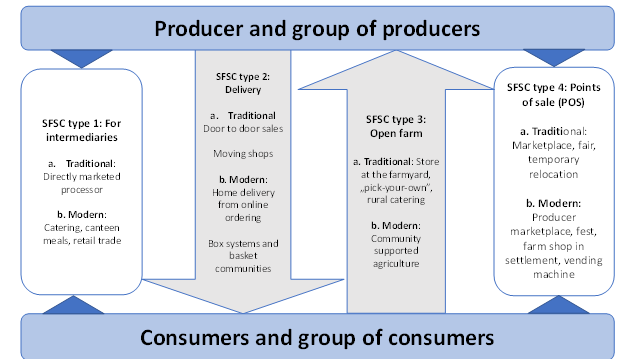
Figure 4 Marketing types of SFSC and the framework of SFSC. Source: Hungarian RDP 2014-2020 Juhász (2014.) based on Nihous (2008), Kneafsey et al. (2013) and Juhász et al., (2012).
The determination of products typically marketed in short supply chains is tightly connected to the definition of SFSC. We distinguish three types of SFSC products that determine the applicable short chains for example niche markets can be sold on touristic or city markets (Juhász, 2014).
Self-sufficiency SFSC product: unprocessed products originated primarily from social enterprises and self-sufficient farms. These products are utilised mainly in the institutional catering of local governments aiming to reach self-sufficiency.
Economy development SFSC product: reliable farm products that represent part of the usual food consumption of households:
- unprocessed product: basic product of plant origin, fresh meat (greater demand, more frequent purchase, lower unit value, the effect of seasonality is strong)
- processed product (smaller demand, less frequent purchase, higher unit value, the impact of seasonality is weak)
Niche market SFSC product: unique products with high added value. These products can be marketed for special occasions as presents.
THE FACILITATOR
One of the key success factors of setting up and getting support for collaborative SFSCs is the presence of a coordinator who often must act as a mediator/facilitator/animator rather than a leader (Kneafsay et al., 2015). For a successful SFSC, it is necessary to coordinate the relations among the actors, and planning is also important to be able to supply the needs of the consumers. These specially formed persons shall be able to facilitate the access to a market of small farmers because they will be able to organise farmers’ associations, solve conflicts between farmers and consumers, look for special supports, analyse the changes of markets, help marketing actions. This activity is one of the key drivers of social cohesion, social innovation because the reform of local farmers’, consumers’/citizens’ cooperation is essential for the development of short food supply chains. These qualified persons shall be able to generate social innovation activities in their territories. Locally qualified people can build new networks, diversify local cooperation, and create added value by bonding local farmers, consumers, and rural stakeholders. They all will become social entrepreneurs as they will contribute to rebuild and re-identify the local cooperation matrix for a better quality of life and more attractive rural areas.
In many countries, facilitators are responsible for setting up SFSC groups and organizing them. The main steps of the establishment are the following:
- Inventory making
- Food system analysis
- The preparatory phase of alignment
- Training and education
- Planning common activities
THE MAIN CHARACTERISTICS OF EUROPEAN SFSCS
As it was discussed in the previous chapters the high number of steps, and the increasing distance between production and consumption, are at the basis of the “revolution” brought by Short Food Supply-Chains initiatives, especially in Europe. The content is based on 18 case studies in the frame of the Smart chain project and former EU-funded programs.
SFSCs have gained increased political attention considering the beneficial outcomes they are likely to provide for the economy, the environment, and society (EIP-AGRI, 2015; Kneafsey, 2013; Galli and Brunori, 2013). However, the extent to which SFSCs contribute to sustainability is still an open question on many issues. Environmental benefits of SFSCs - regarding food miles, carbon footprint, using chemicals - are still under consideration by researchers. 
Figure 5 Main characteristics of European SFSCs. Source: Euractive (2018) and Augère-Granier (2016), own composition.
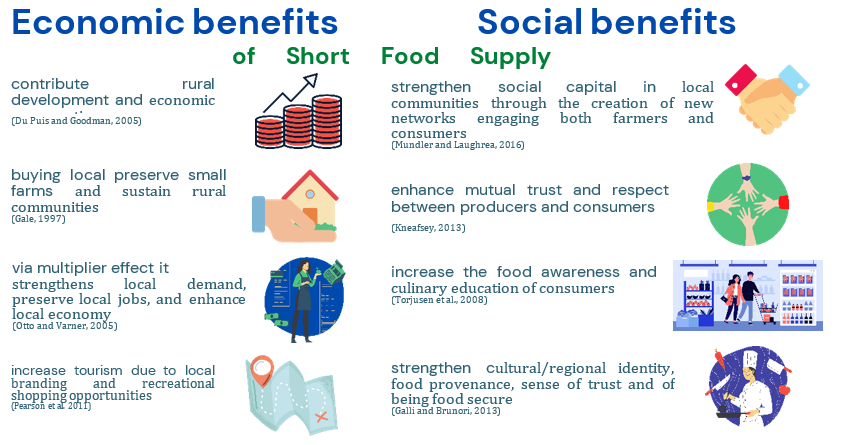
Figure 6 Economic and social benefits of SFSCs, Source: own composition.
PRACTICAL GUIDE FOR BEGINNERS TO FACILITATE SFSC
This subchapter deals with the practical aspect of SFSC organization. As it was already mentioned the key persons of the successful SFSC collaborations are the coordinators who are defined in our handbook as facilitator or organiser. Firstly, we will give tips for the market organisation than among “Exercises” European best practices will give an exact presentation on adaptable solutions.
Main steps to set up short food supply chain groups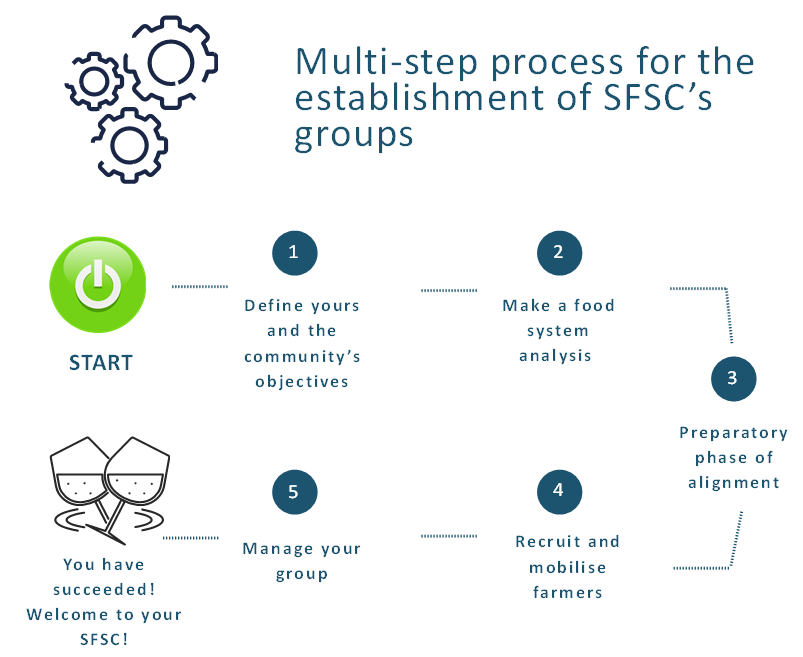
Figure 7 Multi-step process for the establishment of SFSC’s groups. Source: own composition based on Kujáni, 2018.
Step 1: Define your and the community’s objectives
Identify common and local motivation
First, we should answer some questions before starting the collective actions in our territory:
- Why do we want to initiate this project?
- What is the interest of our community?
- What are my objectives?
Within these questions, we try to find out the focus of our plans. Finding partners for our aims will be easier if we can determine the objectives which fit our and the communities’ interests.
- Support small farmers (whose main activity is not agricultural production)
- Strengthen the multifunctional family farms
- Recognise local products
- Help the farmers and local actors to cooperate
- Increase consumers’ interests and serve the demands of local consumers
- Include tourist destinations
- Boost local economic development
- Build an own company
- Increase urban farming
Identify the local stakeholders
The identification of local stakeholders is a key step to reach our potential partners. The wider the range of cooperative stakeholders, the stronger will be the local embeddedness of your project. Try to collect more and more enthusiastic stakeholders, volunteers, and certainly farmers, food producers, or craftsmen for your project. 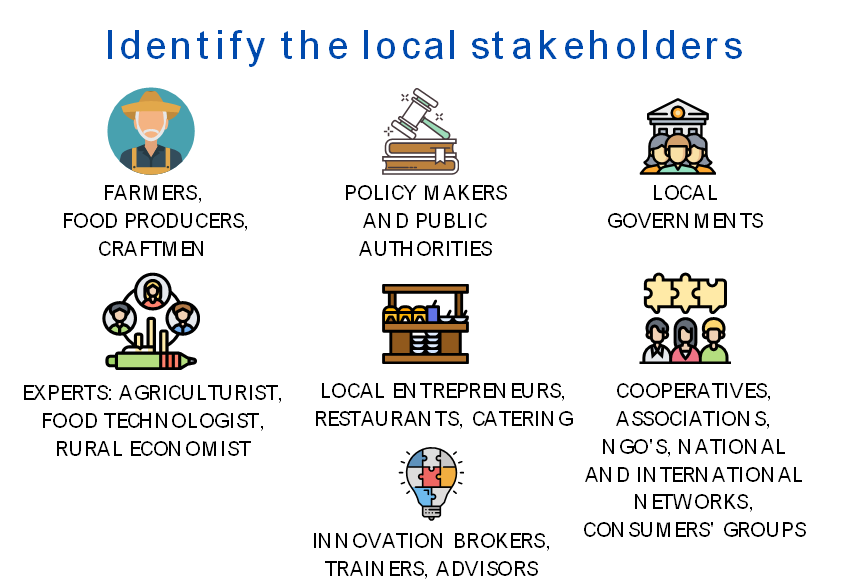
Figure 8 Types of local stakeholders. Source: own composition.
Step 2 Make a food system analysis
Analysis of local endowments
In this step we study the local circumstances to know with which tools can we achieve our main objectives. It can be a summarized feasibility study that can describe the possibilities for local actors besides, later you can use it for financial claims.
In this step the further questions shall be raised:
How is the agricultural production in our territory? Is there any traditional local food or protected food? What are the main produced vegetables and fruits, breeding animals?
- Who are the processors e.g.: slaughterhouses, bakery?
- Who are the farmers and how big is their production potential?
- Who are the actors of the chains (long, short)?
- Where people spend their money on food?
- What are the main barriers for farmers during their sales?
- Who are the potential consumers in our area?
If we have the opportunity to lead a consumer perception questionnaire, we could get more knowledge on their purchasing habits, expectations about food, and attitude regarding local food. In this step, the making value proposition (see the chapter “Business thinking for Rural Facilitators”) is a tool for more precise business planning.
Examining the already working short food supply chains helps to understand the barriers and insights of local food sales. We can also determine which channels can work locally. At the end of this step, we get to recognize the real problems of local stakeholders and define possible answers; to identify local stakeholders and partners. Furthermore, we can know and define our territory, and the location of our project. We can get the response if it is wide enough to provide our consumers with a wide assortment of fresh local products or should it be widened?
b) Selection of farmers and products (control system)
In this step, you should create a selection and a control system for your activity. In this phase, you will just identify the criteria for how you will select your partners. We suggest doing it together with farmers and other stakeholders. This criteria system will allow you to control farmers and maintain the pre-identified quality level. You can determine criteria as basic conditions to enter into the group. In many SFSC we can see that facilitators help farmers to use national and EU support to be eligible for SFSC conditions. It is also a good tool to strain the cheating farmers or retailers to build trust with consumers and partners. 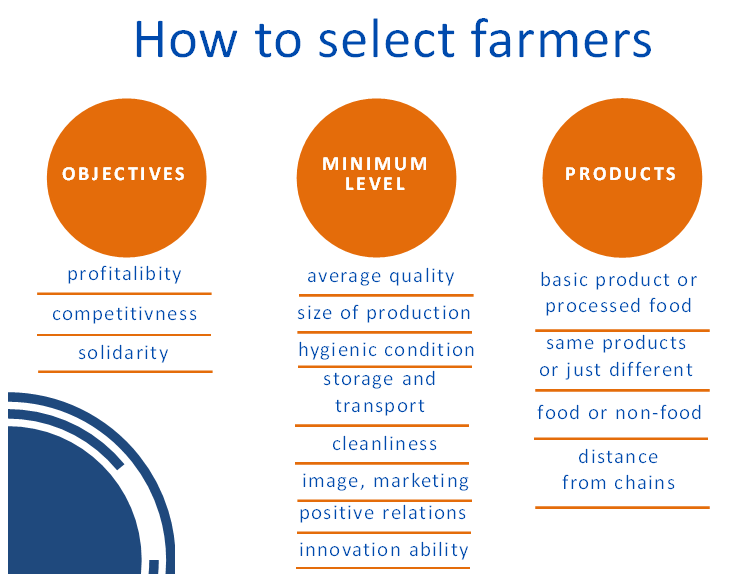
Figure 9 Criteria system. Source: own composition.
During the cooperation building up, you should clearly define your expectations from farmers and define the joining criteria which will ensure transparency for your group. It is important to make the decision together on these benchmarks and write them into a common agreement/Charte/intern policy to avoid a further clash of view. These criteria must be controlled regularly and warned for misalignments.
Step 3: Preparatory phase of alignment
After the first decision that you want to cooperate and do an SFSC, you should choose between the most fitted legal forms which can serve your purchasing and collaboration purposes. Moreover, you must overview all the connected regulations step-by-step. As a facilitator, it is your task to warn farmers and sellers about regulations regarding food production, labels, vignettes, and trade. In many cases, the understanding of a complex regulatory framework means the biggest challenge for the groups and sometimes the barriers as well. The EU and states try to provide guidelines for small farming regulations and catering which can help at the starting point.
Regulatory framework
- Appropriate legal form
- Tax system: VAT categories
- Trade law: what kind of short chains do exist?
- Food safety regulations
- Labour Law
- The special direct sale or SFSC regulations
- Labels
- Vignette
- Promotion
Diversification
- Formal and informal organisation forms
- What kind of legal forms exist?
- What is the objective of the cooperation?
- Resources sharing, increasing negotiation power, cost-sharing
- What kind of activities do they want to share?
- Production, processing, packaging, promotion, storage, distribution, selling, advertisement.
- Who are the consumers?
- What kinds of relationships are between the actors?
- Food or non-food
Step 4: Recruit and mobilise farmers
To get in contact with your group you must take your time and visit all the farmers in person. You can create a group of farmers and other stakeholders who can organise the visits where you can make sure of the fulfilment of criteria and mainly the cleanliness.
If you want to involve the farmers you can organise tasting events, workshops where they can present themselves and their products for consumers, chefs, restaurants, and so on.
We recommend you to create a strong community from your farmers, to discuss and to listen to them. Every opinion counts. You must take care of your farmers’ opinion regarding the common work and be a good leader not only a boss.[2]
Some tips about creating a team from your farmers:
- organize study trips to visit good practices (expend time on social activities)
- organize social events, workshops, training regarding the development of your activities
- celebrate birthdays, anniversaries of your group
Step 5: Manage your group
If you already have a strong community of farmers, don’t let it collapse. Don’t forget, it is hard work to maintain this status quo, but it's worth it!
Everyday activities for an excellent facilitator:
- Acting as the main contact person of „market”
- Overseeing day-to-day market operations
- Collecting user fees
- Obtaining proper permits and insurance
- Enforcing rules and regulations
- Recruiting farmers and local volunteers from enthusiastic consumers
- Controlling farmers and product mix
- Excluding cheat
- Handling complaints and disputes
- Working with markets’/SFSCs’ board
- Establishing strong community contacts
ATTRACTIVE LOCAL MARKET ORGANIZATION
As it could be seen in previous chapters, a short food supply chain has various forms, however, they all have one purpose, bringing closer locally made products to local citizens. Farmers’ market is one of the most important forms of direct selling. But setting up and operating such a popular way of SFSCs seems not so easy. There are more questions to be considered when starting a new farmers’ market. This part of the chapter intends to give some practical advice for SFSCs’ organizers setting up a successful farmers’ market.
Location and opening hours
Choosing the right place for the market means a key element to our success. The place of the market must be reached easily by public transport and by car. You need an appropriate parking place if it is possible without any parking fee. Close parking places for vendors are required. The number of customers can be increased by finding a place close to other shops.
Some questions for consideration
- Is it on grass or stable ground? How can you protect your ground in extreme weather conditions?
- Is it possible to use the location for the long term? Market entering is a long process, so if you do not have permission to use the place for several years, you should look for other options.
- Is it a covered place or not? If not, can farmers’ tents be fixed easily? Can the market be organized in bad weather conditions? Do the farmers have any tents or do you need to install some of them?
- How many vendors would you like to invite to your market? Do you have enough places for them?
Before choosing a location for your market, please check the regulation of your country regarding hygienic requirements!
Before defining opening hours, you must examine other markets in your surroundings
- Do not organize your market on the same days as your rivals do.
- Determine your consumer’s target groups and set your opening hours to their expectations.
- If you have chosen the appropriate day or days and hours, do not modify it often! Customers cannot tolerate it.
- Extraordinary market days must be announced long before it and promoted parallel on more marketing channels.
Before promoting and opening your market, be careful and get every license that your country’s regulation requires!
Farmers and consumers
All farmers in farmers’ markets are selling their products. Market organizers have to check if farmers are selling their own crops or not. Visiting the farms is the best tool for checking and it deepens the trust between farmers and organizers. You have to maximize the number of farmers and the distance from when they could come. Selling distance from farm to market is regulated usually by the government.
Consumers like markets that offer variety. You need to supply the core foodstuffs throughout the year. But consumers like specialities as well. So, pay attention to recruit your producers!
Examine your consumers’ demand, prepare market research!
Rules
For successful operation, you need written documents that regulate rights and obligations. Some rules come from your state authorities, some rules come from your common decision with farmers. Common decision-making increases engagement. Rules must be accepted by all farmers.
Do not be afraid of expanding your list. The market is changing, you cannot forecast every situation.
As a market organizer, you must predict and mediate conflicts between farmers or even between consumers and farmers. Conflict management knowledge will be useful.
Some rules are valid also for customers, like smoking rules or wearing masks, etc.
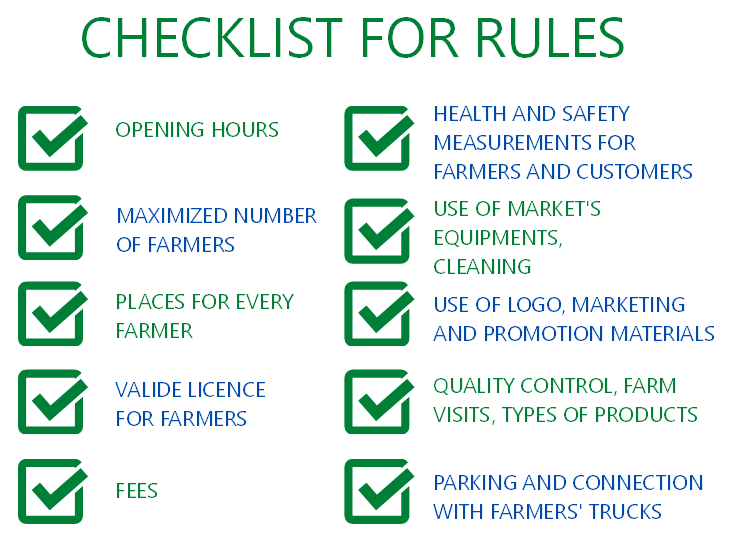
Figure 10 Checklist for farmers’ market organizers. Source: own composition.
Coordination and financial background
First, you need an effective team to coordinate the market. You can involve several organizations like the chamber of agriculture, NGOs, local public authority, church organizations, garden clubs, seniors, and enthusiastic volunteers. These stakeholders can help you not only in the organization but in the financial background.
You need a plan for annual business operation, listed the expenses and incomes. It should be in balance. If not, you must consider increasing the fee. But you should take care of your farmers’ incomes on the market. Different sized farms can pay different fees. Or you can ask some organizations in your surroundings to support your market.
Promotion and special events
Be visible!
Use marketing channels according to your customer’s target groups! Younger people can be reached by social media, seniors like fliers or radio podcasts better. Permanent signs, banners at the market’s location are effective for every target group.
Holding a special event at your market can generate free promotion and win new customers. A market is a meeting place for the local community. Do not go only shopping in the market, but meet old friends, discuss and try new recipes, or take part in cultural events.
Suggested types of events
- music
- food tasting
- cooking with local chefs from local ingredients
- events for holidays (Christmas, etc.)
- activities for kids, handicraft workshops
Generate special events for the whole family!
COVID tips
The year 2020 brings a new experience with the Covid-19 situation and the farmer’s markets must react to the new set of intern regulations. That is why we collected some suggestions from practice to ease the organization:
Inform your farmers and customers about the relevant health situation! Check the current regulation of your county!
Recommendations
- ensure physical distancing
- require face covering from everyone
- ensure hand washing or disinfection
- clean and disinfect surfaces regularly
- ensure the opportunity to pay by card
CONCLUSION
The chapter presented that the short food supply chains do not mean new actions, it is the renewal of traditional purchase interactions, however, farmers must adapt to the new trends and consumers’ demands. That is why the innovative way of sales could provide more possibilities for a more sustainable, less vulnerable, and economically viable small farming system. In many cases, farmers need external help for cooperation and marketing actions. This chapter helps to initiate these projects together with local stakeholders by understanding the main process is SFSC.
[1] This regulation was interpreted according to the national or local interests and endowments so please check your country’s regulatory framework before starting SFSC.
[2] The leadership skills are presented in chapter 9.
Chapters
- Introduction
- Rural Facilitator
- Innovative short food supply chains
- Short food supply chain and ecological transition
- Business thinking for Rural Facilitators
- Marketing tips in short food supply chains
- Communication and conflict management for Rural Facilitators
- Leadership Skills
- Glossary
- References
- Authors and their organizations





